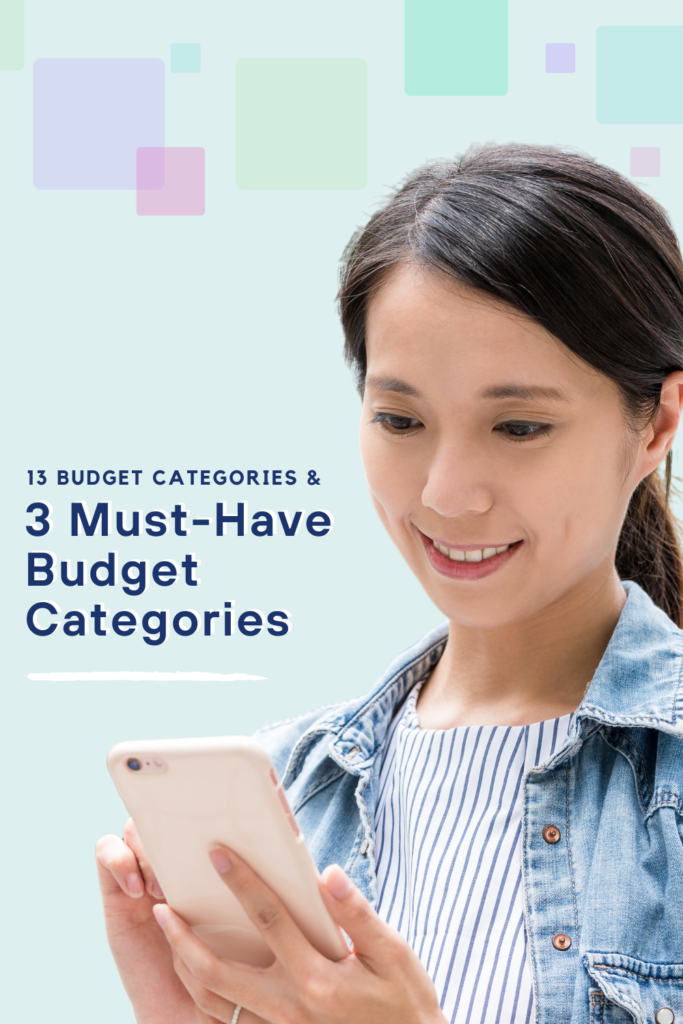Call it a budget. Call it a spending plan. Whatever you call it, you need to make sure you have a way to purposefully divide up your personal budget categories to set money aside each month to cover your spending, and to account for your savings.
Knowing how to set up your budget categories can make your budget work for you. To fast-track your budgeting success, we’ve rounded up the most common budgeting categories and three more that tend to be missed.
The Big Three Personal Budget Categories
The big three personal budget categories that account for 70% of spending are housing, food, and transportation.
Of course, depending on where you live, the diet you follow, and how you get around, your budget categories and their respective amounts could look quite different.
Related: Budgeting 101: How to Create a Good Budget
1. Home
If you’re a renter, this category should cover your monthly rent. You also want to think about renter’s insurance.
As a homeowner, you should budget enough to cover your mortgage, your property taxes, your homeowner’s insurance, and routine home maintenance. No matter where you live, your housing category might also include savings for new furniture or home decor as well.
2. Food & Dining
Do you know how much of your income you eat each month? Melody Wright, Ph.D., CFEI, and Financial Empowerment Coach, says, “The common budget category people should focus on is their grocery/food budget. This budget category is where people spend the most without realizing it.”
Read: My Food Budget is Out of Control
You may choose to lump groceries with dining out or separate the two to keep a closer eye on what gets eaten where.
3. Auto & Transportation
Are you a one-car or two-car household?
In addition to accounting for costs like parking passes and fuel, you need to set aside money each month for general car maintenance and insurance. Depending on where you live, you could also pay taxes or registration fees each year.
It’s also worth noting, as your vehicle ages, expenses can get more costly. Keep a close eye on this personal category and adjust as needed.
More Common Personal Budget Categories You Might Need
If you think you’re done budgeting because you’ve figured out the top three personal budget categories, you’ve got another thing coming.
The key is to make sure your budget works for you and your situation. Choosing the right categories can help you do precisely that.
Melody Wright emphasizes the personal nature of budgets. She says, “When putting together a budget, you may overlook the reality of your spending. Most want to create the ‘perfect’ budget, so they tend to under-budget in areas where they spend the most. My advice here is to recognize you’re not a machine, and certain categories need more attention than others to create a budget you can stick with.”
Consider this advice as you review more common budget categories you might need.
4. Health & Fitness
Have you ever had this thought, “No gym membership, no problem”? Even if you don’t expect to spend much on health and fitness each month, it’s a category you should consider.
Even if it’s setting aside a bit of money each month to replace running shoes or to cover the cost of a prescription. If you find this budget category to be sizable, don’t beat yourself up. Health is wealth, and many of us wish we discovered this truth much sooner.
Read: 13 Ways to Live a Financially Healthy Life
5. Bills & Utilities
While you might be tempted to lump this into housing or other budget categories, giving your utilities its own section in your budget is helpful.
It can also be motivating to help you conserve energy to reduce your electric and gas bills. Plus, it can help you notice price hikes in streaming services, cable packages, or cell phone plans.
6. Travel
Even if you’re more of an armchair traveler than a globetrotter, a travel fund is still a good idea. That way, if you want or need to visit family, you can.
It can also help cover the cost of weddings or other celebrations you might be invited to attend on occasion.
7. Shopping
No-spend challenges are prevalent in the personal finance community. While it can be fun, enlightening, and empowering to see how many days or weeks you can go without shopping, there’s a good chance you’re going to go shopping at some point.
Set aside a monthly amount that works for you.
8. Kids
You may choose to create several budget categories for your kids. You might have one that covers daycare and another that covers monthly expenses (hello, diapers!). If your kids are older, this budget item could include the cost of sports, music lessons, tutoring, and more (hello, braces!).
Read: 10 Important Money Lessons to Teach Kids
9. Personal Care
Personal care is a predictable ongoing monthly expense for some. For others, personal care might mean an occasional summertime pedicure or a bi-monthly haircut.
Even if you don’t anticipate many personal care expenses on a month-to-month basis, setting aside money each month for periodic expenses is helpful. That way, when you do incur an expense, you’re not scrambling to cover it.
10. Education
Typically, when we talk about budget categories that include education, you may assume it only applies if you have children. In that case, this category might cover current school fees. It could also include 529 savings plans to set money aside for higher education or private school.
Additionally, whether we have children or not, many of us could find ourselves in a position where we need continuing education. You may be lucky to have the cost covered by your employer; however, many times it isn’t covered at all or you have to wait to be reimbursed.
11. Gift & Donations
If your goal is to be more generous, a giving category for donations should be considered. You might also use this budget category to cover gifts for weddings or birthdays. That way, you can celebrate care-free (until Uncle Bob asks you to do the Chicken Dance with him).
For those who tithe, that might already be a non-negotiable budget category or you might include that within this category as well.
Read: Should I Donate If I’m in Debt?
12. Savings
The most common tenet of personal finance is to pay yourself first.
Paying yourself first is hard to do if you’re not budgeting a set amount each month for savings and investing. To be intentional with your savings, you need to give yourself a number you’re committed to setting aside each month. Otherwise, your savings account ends up with leftovers.
Read: How to Save Money in 2020
Coins and cobwebs aren’t going to move the needle on your savings goals.
13. Miscellaneous Expenses
This personal category is the perfect catchall to keep your budget from getting too granular.
When you first get the hang of budgeting, it can be tempting to budget every single item you might need or want throughout the month. If that works for you, that’s great. Otherwise, you might consider creating a category like this that can cover once-in-a-blue-moon expenses.
Top Overlooked Budget Categories
While many of the previous budget categories are commonly discussed, there are three that are easy to miss. They might not apply to everyone’s situation, but it’s definitely worth asking yourself if these should be added to your financial plans.
1. Car Replacement
You may be great about budgeting for car repairs, but what happens when you get to the point it no longer makes sense to pour money into your car?
Buying a new car should rarely come as an actual emergency. You don’t want to tap your emergency fund for this expense. Instead, consistently set aside money for that new (or new-to-you) car you’ll buy eventually, in addition to saving up for routine maintenance and repairs.
2. Custodial IRA for Minors
These IRAs are turned over to your children when they’re of legal age. Then, they can be used for higher education. They can also be used to give your child a head start toward buying a first-time home or even retirement. It’s important to note that qualifying for a custodial IRA means your child has an earned income.
Related: Wanting to Teach Kids Money? Do It Based on Their Learning Style
3. Random Acts of Kindness
Let’s say you’re in line at Starbucks only to discover you’re in the midst of a pay-it-forward chain. Maybe your neighborhood or coworkers are setting up a meal train to celebrate a bundle of joy or extend their sympathies.
There are many reasons why you might want to perform random acts of kindness. You don’t want to leave yourself in a pinch, so plan ahead. That way, you can celebrate spontaneously without sabotaging your finances.
Final Thoughts on Budget Categories
No two budgets look the same, which is why no one should expect their budget categories to be identical to another person. In fact, as you progress on your money journey and your family changes, too, it’s likely your budget categories will evolve with you.
Bookmark this list to review occasionally and make sure you keep an eye on your budget. It’s the best way to make your money work for you.






![Everything You Need to Know About the Cash Envelope System [+ Sample Budget]](https://blog.qubemoney.com/wp-content/uploads/2020/01/1-20-20-the-cash-envelope-system-blog2-440x264.png)

